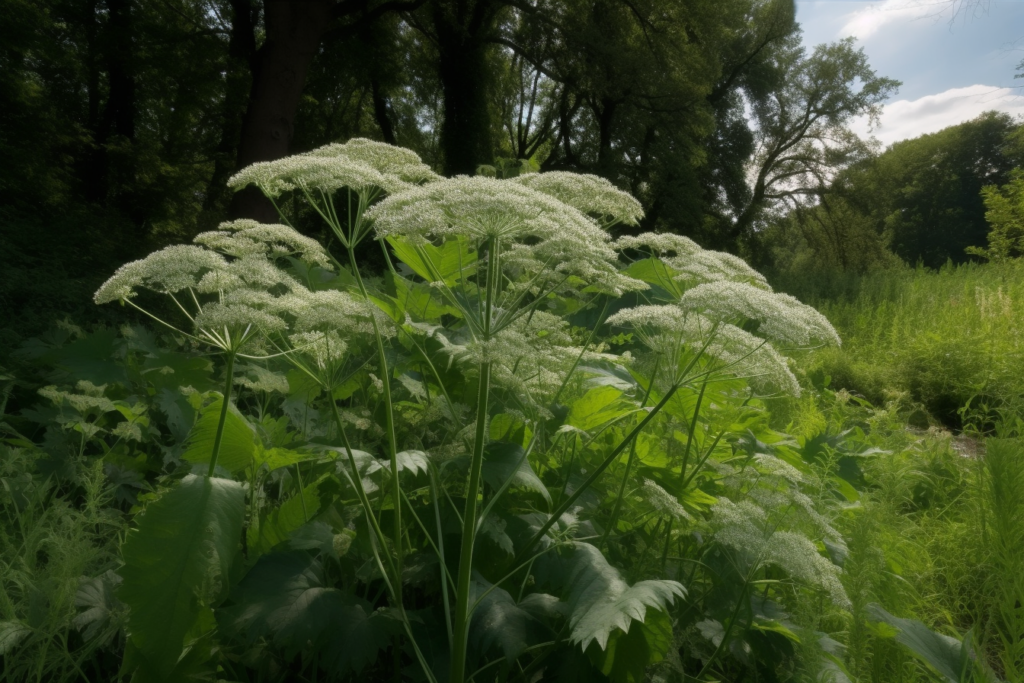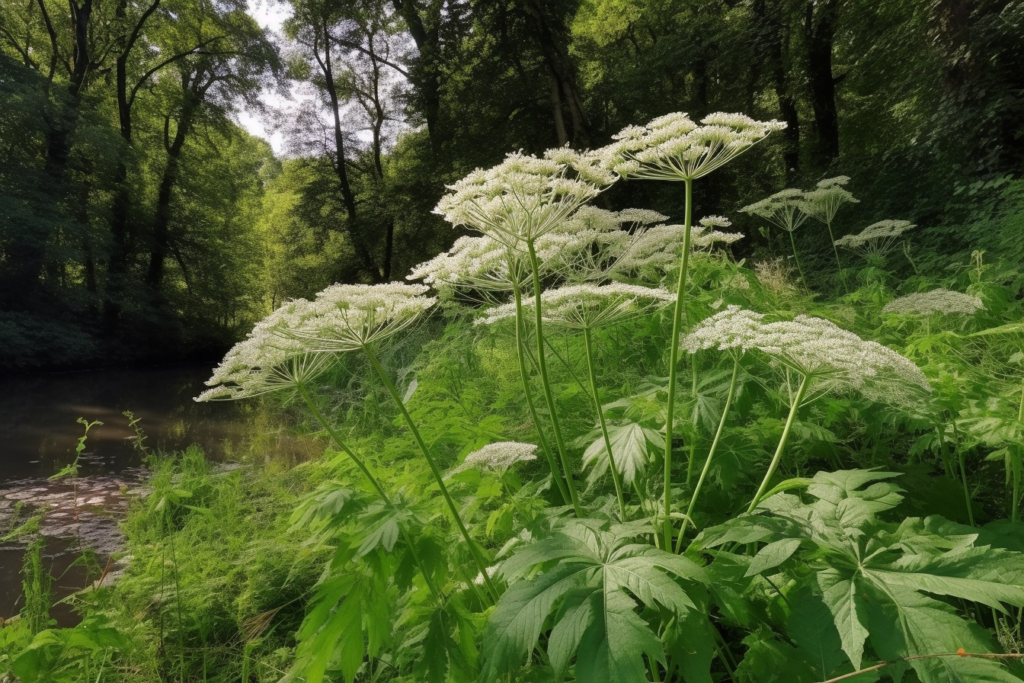Giant Hogweed (Heracleum mantegazzianum) is an extremely invasive weed that poses significant risks to both human health and the environment. This towering plant, known for its impressive size and distinctive features, has gained notoriety due to its harmful effects on the skin and its ability to dominate native plant species. In this article, we will explore the characteristics of Giant Hogweed, its impact on ecosystems, effective methods for control and prevention, and the importance of taking necessary precautions.
Understanding Giant Hogweed
Giant Hogweed belongs to the Heracleum genus and is native to the Caucasus region. It was introduced to Europe and North America as an ornamental plant in the 19th century but soon became an aggressive invader. The plant can reach heights of 15 feet or more, with stout hollow stems and large, deeply lobed leaves.
Botanical Features
Giant Hogweed is easily recognisable by its enormous size and striking features. Its stems are covered in purple blotches and coarse bristly hairs, while the leaves exhibit a deep green colour and a circle of white hairs at their base. The leaves are deeply lobed and can grow up to 5 feet in diameter, resembling a palm shape. The plant produces white flowers arranged in umbrella-like clusters, forming a flower spike that can span up to 2 feet in diameter.
Seed Characteristics
Giant Hogweed produces an abundance of seeds, contributing to its successful spread. The seeds are brown, flat, and oval-shaped, measuring about 1/4 inch in length. The plant’s seed bank can contain thousands of dormant seeds that remain viable in the soil for many years. This resilience makes eradication efforts challenging, as new plants can emerge even after years of control measures.

Toxicity and Skin Reaction
One of the most significant dangers associated with Giant Hogweed is its toxic sap. The plant’s tissues contain a photosensitive chemical that, when exposed to sunlight, can cause severe skin inflammation and blistering. The reaction occurs when the sap comes into contact with the skin and is triggered by exposure to sunlight.
Skin Contact and Reaction
Direct contact with Giant Hogweed sap can result in painful skin burns and blistering. The severity of the reaction depends on an individual’s sensitivity and the concentration of the sap. Skin inflammation can occur within minutes after contact, while the full extent of the burn may develop over several hours. If left untreated, the effects can last for weeks, leaving the skin vulnerable to infection.
Photosensitivity and Phytophotodermatitis
Giant Hogweed’s sap contains a photosensitive chemical called furanocoumarins. When this chemical comes into contact with the skin and is exposed to sunlight, it triggers a reaction known as phytophotodermatitis. The combination of the sap and sunlight can cause the skin to become highly sensitive, leading to burns, blistering, and long-lasting skin discolouration. It is important to note that the reaction can occur even on cloudy days when UV rays can still penetrate the skin.
Ecological Impacts
Giant Hogweed poses a significant threat to human health, biodiversity, and the natural balance of ecosystems. Understanding the risks and impacts is crucial in devising effective control measures.
Competitive Advantage and Habitat Disruption
The aggressive growth of Giant Hogweed allows it to outcompete native plants, leading to a reduction in biodiversity and ecological disruption. The plant’s sheer size shades out smaller plants, limiting their access to sunlight and nutrients. This disrupts the natural balance and reduces the variety of plant and animal species in affected areas.
Seed Production and Dormancy
Furthermore, Giant Hogweed has a high seed production rate. It produces an abundance of seeds that contribute to its successful spread. These seeds can remain dormant in the soil for many years, forming a seed bank. Even after successful control measures, new plants can emerge from these dormant seeds, making eradication efforts challenging.
Impact on Streambanks and Riparian Areas
Giant Hogweed poses a particular threat to streambanks and riparian areas. The plant’s robust root system can destabilise soil and contribute to erosion along waterways. This, in turn, affects water quality and aquatic habitats, potentially harming fish and other aquatic organisms.

Managing Giant Hogweed
To effectively manage Giant Hogweed infestations, it is essential to employ comprehensive control strategies. Here are some methods commonly used to combat this invasive weed:
Identification and Reporting
Educating the public about the identification of Giant Hogweed is crucial for early detection and control. Local authorities and environmental agencies should provide resources to help individuals recognise the plant and report its presence promptly.
Mechanical Control
Physical removal of Giant Hogweed is a common method, involving the cutting or digging out of the entire plant, including the roots. This approach should be executed with caution, ensuring proper protective gear to prevent skin contact with the sap.
Chemical Control
In cases of large infestations, herbicides approved for Hogweed control may be necessary. However, their use should comply with local regulations and environmental guidelines. It is important to carefully follow the instructions provided by the manufacturer and use herbicides responsibly.
Preventive Measures
Preventing the spread of Giant Hogweed is crucial to mitigating its impact. Regular monitoring of previously infested areas is essential to catch any new growth early on. Additionally, promoting the use of native plants and discouraging the cultivation of invasive species helps maintain healthy ecosystems.
Precautions and Safety Measures
To minimise the risk of exposure to Giant Hogweed, it is important to take the following precautions:
- Wear Protective Clothing: When working near Giant Hogweed or attempting to remove it, wear long sleeves, long pants, gloves, and goggles to protect your skin and eyes from the sap.
- Avoid Sunlight: If you come into contact with Giant Hogweed sap, avoid direct sunlight on the affected area for at least 48 hours to prevent a severe skin reaction. Seek medical advice if necessary.
- Wash with Cold Water: If you accidentally touch Giant Hogweed sap, immediately wash the affected area with cold water and soap. Cold water helps to minimise the skin’s reaction.
- Seek Medical Attention: If you experience severe skin burns, blisters, or an allergic reaction after contact with Giant Hogweed, seek medical advice promptly.
Conclusion
Giant Hogweed, with its towering presence and toxic sap, is a formidable threat to both human well-being and the environment. Swift action is necessary to control its spread and minimise its harmful effects. By raising awareness, implementing effective management strategies, and taking necessary precautions, we can protect our ecosystems and ensure the safety of ourselves and future generations.
Additional Resources

Faye is a valuable contributor at Glenlivet Wildlife, with a degree in Botany and expertise in plants and flowers. She has embarked on expeditions to remote areas, interviewing renowned botanists and biologists to provide unique insights into flora worldwide. Her favourite flower is the Jade Vine, admired for its beautiful colour and delicate appearance.
